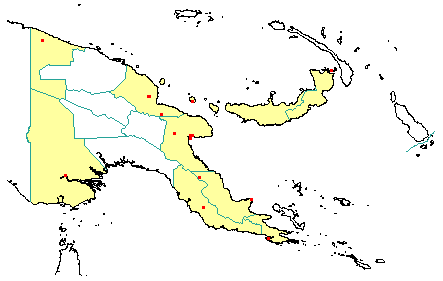
in PNGplants database
PNGTreesKey – Sterculia shillinglawii F.Muell. subsp. shillinglawii |
Barry Conn (NSW) & Kipiro Damas (LAE).
Guide to trees of Papua New Guinea
Copyright held by the authors, National Herbarium of New South Wales, and Papua New Guinea National Herbarium
Australasian Journal of Pharmacy Vol. 2: 44 (1887)
Other Literature: G.M. Tantra, Lembaga Penelitian Hutan 59-62 (1976)
Family: Malvaceae
Dicotyledon
Timber Group: Commercial hardwood
Field Characters: Large canopy tree (up to c. 30 m high); Bole cylindrical (up to c. 120 cm diam.); straight (bole up to c. 20 m long); buttresses buttresses absent; spines spines absent; aerial roots aerial roots absent; stilt roots stilt roots absent; Bark pale grey or brown (pale (mottled), slightly rough or smooth, slightly pustular, lenticels irregular; Subrhytidome (under-bark) green; less than 25 mm thick; bark blaze consisting of one layer; faintly to non-aromatic; outer blaze white, yellow (pale (cream-coloured), or pale brown, fibrous; inner blaze yellow (pale (cream-coloured), white, or pale brown, fibrous; bark exudate (sap) absent; terminal buds not enclosed by leaves.
Indumentum: Complex hairs present, star-like (stellate); stinging hairs absent; mature twig indumentum (hairs) soon absent or present when young, hairs sparse to dense.
Leaves: Leaves spaced along branches to clustered at end of branches, spiral (leaves occurring singly at a node and arranged spirally up the branchlet), simple (a leaf composed of a single blade); petiole present, not winged, attached to base of leaf blade, not swollen to swollen (slightly (at base); leaves slightly broadest above middle or broadest at or near middle, (11.0-) 15.0-30.0 (-34.0) cm, 6.0-14.5 cm; symmetric, entire, not dissected or lobed, acuminate (shortly) or obtuse, venation pinnate, secondary veins open, prominent, intramarginal veins absent; leaves lower surface green or brown (with reddish brown hairs), upper surface green, indumentum (hairs) present (on lower surface), indumentum (hairs) dense; absent; domatia absent; stipules present, free, laterally placed, not encircling the twig, leafy (triangular), not fringed, large (3-4 mm long), not persistent (soon dehiscent, only present at growing point of branchlets).
Flowers: Inflorescence axillary or on the trunk or branches (on branchlets below leaves), flowers on a branched axis, cones absent; flowers unisexual, unisexual with male and female flowers on the same plant, stalked, flowers with many planes of symmetry, 8.0-10.0 mm long, diameter small (up to10 mm diam.) (5-7 mm diam.); perianth present, with all sepals and/or petals (hence tepals) similar, inner perianth red (on inner surface near base), cream-coloured, or pale yellow; 5, some or partly joined (forming a perianth tube and 5 perianth lobes); stamens 20 (c. (male flowers), absent, joined (to form a staminal tube around the ovary and style), free of the perianth; ovary superior, carpels separate (when more than one), locules 3-4; styles free, 3-4.
Fruits: Infrutescence arranged on branched axis, fruit 60.0-70.0 mm long, 15.0 (c.) mm diam., bright orange, bright red, or brown (densely hairy), not spiny, non-fleshy, aggregate, dehiscent, follicle; seeds 2-4, about 10 mm long (c. 8-10 mm long), not winged, broad (as wide as long) (olive-green to almost black, glossy), seed 1-10 mm diam. (5-6 mm diam.).
Distribution: West Sepik, Madang, Morobe, Western, Central, Northern, Milne Bay & New Britain.
 | Botanical records in PNGplants database |
Notes: Notes The genus Sterculia was previously classified in the family Sterculiaceae. Sterculia conwentzii K.Schum. And S. multinervia Rech. Are both included in this species.
An additional subspecies, namely subsp. malacophylla has straight fruits (follicles) that are fissured on the outer surface, whereas subsp. shillinglawii F.Muell. has generally curved, relatively smooth fruits. The collection from the Kamiali Wildlife Management Area (Morobe) (Takeuchi 15181) (refer image of collection) is not thought to be Sterculia shillinglawii.